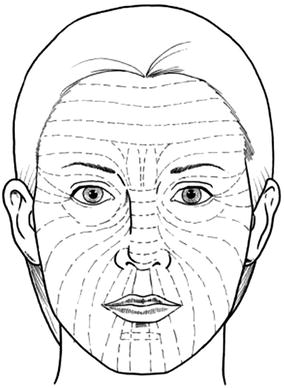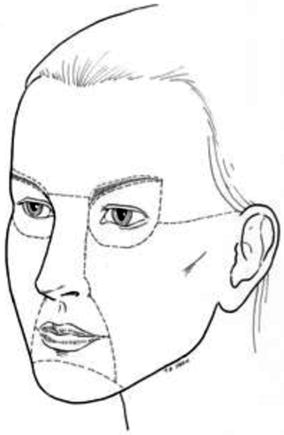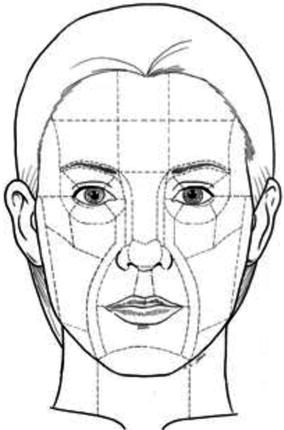, Madan Ethunandan2 and Tian Ee Seah3
(1)
Poole Hospital NHS Foundation Trust, Poole, Dorset, UK
(2)
Department of Oral and Maxillofacial Surgery, University Hospital Southampton NHS Trust Southampton General Hospital, Southampton, UK
(3)
Orange Aesthetics and Oral Maxillofacial Surgery, Singapore, Singapore
The decision to reconstruct facial defects needs to take into account various factors, which includes the final aesthetic outcome. Aesthetic aspects are more important in the face than almost any other part of the body. An understanding of the concept of facial aesthetic units and subunits and the factors influencing the placement of incisions/scars can help the clinician obtain the most cosmetically pleasing outcome.
Relaxed skin tension lines (RSTLs), described by Borges, result from the orientation of the collagen fibres in the skin (Fig. 2.1). They are manifested as furrows/creases when the skin is relaxed and can be made more prominent by pinching. The furrows extend for longer and are made with greater ease, when the skin is pinched at right angles to the RSTL. Wrinkle lines, described by Kraissl, are formed at right angles to the underlying muscle fibres and are made more prominent in response to differing facial expressions. They often, though not always, follow the RSTLs. The above should not be confused with Langer’s lines, which are described as “cleavage lines” in a cadaver and were never intended to delineate the ideal lines for incisions.


Fig. 2.1
Orientation of RSTL’s
RSTLs are perpendicular to the lines of maximum extensibility (LME), which are dependent on the orientation and stretching of the elastic fibres. Where possible, the excisions and flap repair should be made parallel to the RSTL as this will place the maximum closure tension to be perpendicular to the LME and parallel to the RSTL. There are exceptions (e.g. lower eyelid) and these will be discussed in the relevant chapters.
The face can be divided into specific areas, designated as “aesthetic units”, within which the skin has similar characteristics. These characteristics include colour, thickness, amount of subcutaneous fat, texture and presence of hair. These “units” are separated from each other by relatively well-defined ridges and creases, designated as “aesthetic borders”. The borders include easily discernable landmarks such as the hairline, eyebrows, nasolabial fold, philtrum, vermillion border and labiomental fold.
The principal aesthetic units of the face are the forehead, eyelids, nose, cheek, lips, chin and pinna. To this can be added the scalp and the neck, to encompass the “head and neck” region (Fig. 2.2).


Fig. 2.2
Aesthetic units
Some of the principal aesthetic units can be further subdivided into smaller areas designated as “aesthetic subunits”, which are separated by less discrete borders than that which separate the aesthetic unit (Fig. 2.3).


Fig. 2.3
Aesthetic subunits
Some publications refer to the aesthetic units as aesthetic regions. In this book, the term aesthetic unit will be used as defined above. Similarly, some publications refer to the aesthetic subunits as aesthetic units, topographical subunits, etc. In this book, the term aesthetic subunit will be used as defined above.
The aesthetic units can be further categorised for reconstructive purposes, and these will be discussed in greater detail in the next few pages.
Forehead
The aesthetic unit of the forehead is defined by the frontal hairline superiorly, temple and temporal hairline laterally and the eyebrow and glabella inferiorly. It is immediately obvious that hair loss can affect the superior extent of the forehead, which can be modified by hair styling!
The unit can be further subdivided vertically into central, lateral and temporal subunits and in addition, from the reconstructive point of view, horizontally into the lower and upper forehead (Fig. 2.4). The central subunit represents the area between the medial ends of the eyebrow. The lateral subunit extends from the medial eyebrow to the lateral orbital rims. The temple/lateral subunit extends from the lateral orbital rim to the zygomatic arch.


Fig. 2.4
Subunits of the forehead
The principal skin creases are horizontally oriented across the forehead, with the exception of vertical orientation in the glabellar region and a radiating orientation from the lateral canthus in the temporal region (crow’s feet).
Cheek
The cheek is the largest aesthetic unit in the face. It has an undulating contour and is defined by the nasofacial, melolabial and mentolabial folds medially, infraorbital rim and zygomatic arch superiorly, pinna and angle of the mandible posteriorly and lower border of the mandible inferiorly.
Stay updated, free articles. Join our Telegram channel

Full access? Get Clinical Tree








